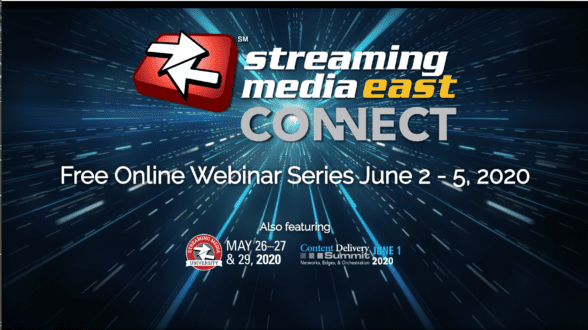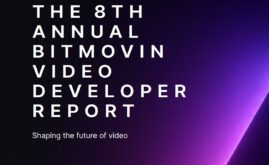Streaming media production and delivery has become even more critical over the last few months; here’s an opportunity to boost your skills and knowledge via live online training by recognized industry experts.
I’m sad that Streaming Media East won’t be held in Boston as planned; I really enjoy those shows. However, Streaming Media East will be held online, with five 3-hour pre-conference training sessions that cost $199 each and a robust assortment of free 1-hour sessions. Here are the titles, dates, and times of the pre-conference sessions hosted by me and my colleagues; here’s a link to the free general program.
I’m particularly excited about Robert Reinhardt’s advanced FFmpeg class, which I plan to attend.
Contents
W1: Introduction to ABR Production and Delivery
Tuesday, May 26, 11:00 a.m. – 2:00 p.m. ET / 8:00 a.m. – 11:00 a.m. PT
Instructor: Jan Ozer
Description: This course helps those new to streaming media get familiar with the relevant terms, concepts, and technologies. The session begins with a definition of terms like codecs, container formats, and adaptive bitrate streaming, as well as encoding concepts like bitrate control (VBR, CBR) and frame types (I, B, and P). Then it details the key H.264 encoding parameters that impact quality and compatibility. Next up is adaptive streaming, including a review of available ABR technologies like HLS and DASH, how to formulate an encoding ladder, and how to use multiple DRMs to protect premium content. Then we’ll review the technical requirements for ABR delivery to computers, smartphones and tablets, OTT devices, and smart TVs, and finish with a quick look at advanced codecs like HEVC, VP9, AV1, VVC, and LCEVC. You walk away knowing the technical requirements for delivering to all key platforms and an understanding of how to do so.
W2: Cloud Streaming Tools
Tuesday, May 26, 3:00 p.m. – 6:00 p.m. ET / 12:00 p.m. – 3:00 p.m. PT
Instructor: Nadine Krefetz
Description: As the COVID-19 pandemic is keeping people home from work, using remote cloud-based applications makes more sense than ever. This workshop will cover a range of SaaS products that promise to provide efficient, affordable alternatives at various points in the streaming video workflow. For each tool, we’ll provide a step-by-step demonstration followed by an in-depth discussion of features, functionality, and pros and cons. This workshop is designed for attendees of all levels of technical expertise who are interested in finding out the latest cloud-based options.
- Collaborative video editing
- Multi-playout management
- Simple app building
- Video analysis and metadata creation by AI & ML
- Audio Transcription
- User testing
- Churn-busting analytics
W3: Key Encoding Skills, Technologies, and Techniques
Wednesday, May 27, 11:00 a.m. – 2:00 p.m. ET / 8:00 a.m. – 11:00 a.m. PT
Instructor: Jan Ozer
Description: This session helps encoding professionals get up-to-speed on crucial encoding-related issues, technologies, and techniques. Topics include:
- The best high-level strategies for delivering to computers, mobile, smart TVs, and OTT (which ABR, codecs, and DRMs are supported by which platforms)
- Current status of the H.264, HEVC, AV1, LCEVC, and VVC codecs; who’s using and where; comparative quality and encoding/decoding performance, and deployment schemas (DASH? HLS?)
- How to deliver HEVC over HLS
- Current status of per-title technologies for VOD and live encoding
- How to build/analyze your encoding ladder using objective quality metrics
- Current status of CMAF and its implications for delivering a single set of files to HLS/DASH players
- How to encode/deliver/protect with dynamic and static packaging
W4: Beginner’s Guide to FFmeg
Wednesday, May 27, 3:00 p.m. – 6:00 p.m. ET / 12:00 p.m. – 3:00 p.m. PT
Instructor: Robert Reinhardt
Description: One of the most widely used tools for video encoding and deployment processes is FFmpeg, an open-source command line utility that can read and write just about any video, audio, or subtitle codec with just about any format, container, or protocol. Starting with core command-line parameters, you’ll learn how to read video files and output in various bitrates, codecs, and containers. The workshop then moves into more intermediate-level commands with map parameters and video filters. We also look at streaming VOD as Live with RTMP distribution to social media and custom ingest destinations.
W5: FFmpeg Advanced: Working with Multiple Sources, Inputs, and Outputs
Friday, May 29, 12:00 p.m. – 3:00 p.m. ET / 9:00 a.m. – 12:00 p.m. PT
Instructor: Robert Reinhardt
Description: If you’re already familiar with the basics of FFmpeg operation, you’re ready to tackle more ambitious tasks with one of the most powerful compositing tools available. In this workshop, we explore the composition of two video sources with text labels and placement, setting up multiple processes to output multiple bitrates for adaptive delivery, using the “tee muxer” to distribute one encoding process to several outputs, and accessing connected hardware (e.g. webcams, A/V capture devices) and networked hardware (e.g. IP cameras) as inputs to FFmpeg processes. Additionally, a diagnostic test will be made available for attendees of this advanced workshop.
 Streaming Learning Center Where Streaming Professionals Learn to Excel
Streaming Learning Center Where Streaming Professionals Learn to Excel









